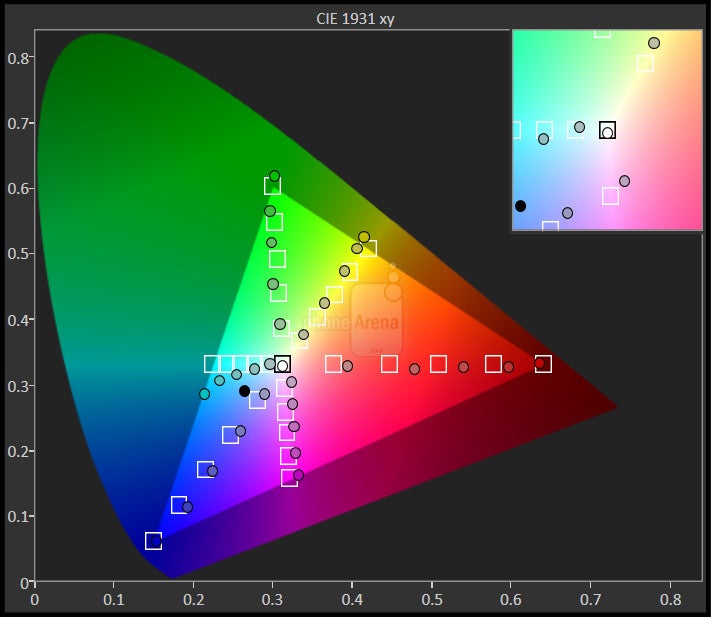Alcatel OneTouch Idol X+ Review
Introduction
Last year's OneTouch Idol X by Alcatel managed to stand out with its excellent value-for-money proposition, as it offered a crisp 5” 1080p display, 13 MP camera and dual SIM abilities for a third less than flagships with similar specs. Alcatel recently outed a successor, OneTouch Idol X+, which goes for the same price a year later, and we are taking it for a spin, in order to determine if it's again a bargain offer.
The Idol X+ upgrades on the weakest spot of the Idol X, boasting the “true octa-core” MediaTek processor, instead of the wimpy quad-core that we had last year, but the other main specs, like the 5” 1080p panel, remained unchanged. Alcatel did add something extra in addition to the processor upgrade, in the form of audio improvements. The Idol X+ ships with JBL headset in the box, and claims to have an enhanced audio output quality, which it calls “Hi-Fi”. Are these enough to warrant the same excitement as its predecessor? Let's find that out...
Design
The dimensions are far from last year's elegant Idol X, but the X+ still flaunts a comparatively thin and light body, that is easier to hold with one hand than other 5-inchers.
We have to admit that we approached the Idol X+ design with mixed feelings. On one hand, it is sufficiently thin and light for a 5-incher, at 0.31” (8.1mm), and 4.59 oz (130g). That's about as slim and heavy as the Galaxy S4, for example. On the other hand, it is not as svelte and feathery, as the 6.9mm Idol X, whose dimensions are really impressive for a 5” phone. Moreover, its glossy back feels a bit slippery to hold, again compared to the soft-touch plastic of its predecessor. What the Idol X+ inherits, however, is the metallic alloy frame around the side, that allows for structural rigidity in a comparatively light chassis. That rim wraps the phone around the sides, interrupted only with slim cutouts for the ports and buttons.
The elongated design of the Idol X+, with its wide top and bottom bezels, is comparatively easy to operate with one hand.. The phone is less wide than the Galaxy S4, for example, not to mention the largish S5, Xperia Z2 or HTC One (M8), all of which also come with 5” displays.. Our only gripe with the design of the Idol X+ is the power/lock key placed at the top, making it a literal stretch to press on such a tall handset. Both the lock key up top, and the volume rocker on the right, however, are easy to feel and press, with decent tactile feedback. The sides also house two card slots - in our dual SIM version they are both for the carrier micro SIM cards, whereas with the single SIM variant you get a SIM slot and a microSD one. The protective flaps that cover those two card slots on both sides come with unorthodox design. They are completely flush with the metal rim around the phone, with only a small “pimple” protruding at their upper parts. When you drag it with your nail/fingertip, the flap opens up, so you can insert the SIM or memory card, then you can slap it back down, and a tiny magnet at the other end locks it in place, keeping it flush with the side surface, and almost invisible. The “pimple” is tiny, however, so it sometimes takes a while to pick it, and keep the flap open.
There are three capacitive navigational keys beneath the display, which are not the most responsive we've tried, but do the job. They are, thankfully, backlit, and the white light sipping through matches the small LED notification dot next to the earpiece slit. There is also a 2 MP front camera up there, as well as an ambient light sensor which works like a charm, dimming the display gradually when the light goes down, or blasting it up outdoors.
With the phone's promise for a “Hi-Fi” sound come JBL-branded in-ear headphones, and what looks like a dual speaker set grills at the bottom. These are not two speakers, however,, but rather mimic such an impression, while the phone houses just a single loudspeaker there.
Display
The 1080p display is sufficiently bright for outdoor usage, and very close to the reference white point, though some colors are off.
The 5” 1080x1920 pixels panel is of the laminated IPS-LCD variety, meaning a tight, bright, low-reflection package, integrating the touch layer into the display itself. Its protection is guaranteed by the durable Asahi Dragontrail glass, which is similar to Corning's Gorilla Glass, and the brand that Alcatel works with on all of its recent phones. With 441ppi pixel density, the screen is a piece of beauty, showing no icon or text jaggies, even if you explore it up close and personal. The color representation is largely decent, when compared to the standard RGB gamut, with the most deviation occurring in the light blue and red hues. The 6289 Kelvins white point is excellent, and very close to the reference 6500 K, so you won't notice an overly cold or warm cast while using the display.
The screen is pretty bright (we measured 447 nits), and with good reflection coating, meaning you won't have troubles viewing it outside, even as we tested under direct sunlight. Brightness and colors shift slightly at extreme viewing angles, but, again, nothing out of the norms for a good IPS-LCD screen.
Interface and functionality
The OneTouch interface is simple and easy to master, but the phone will likely be stuck on Android 4.2 Jelly Bean for the foreseeable future.
Alcatel supplies a tidy OneTouch Android interface overlay on top of 4.2.2 Jelly Bean with the Idol X+. This is two versions prior to the current Android 4.4 KitKat, with no word whether this handset will ever get to KitKat. Its general looks are not far from the stock experience, with the lock screen, contacts, wallpaper and notification bar graphics closely matching it, save for the transparent background. The lock screen shows date, time and weather, or calendar, and you can swipe back and forth between the two without unlocking.
The iconography is big, colorful, and begging to be tapped on. The most used apps have shortcuts placed directly on the home screens by default, and the rest are neatly arranged into categorized Google Services, Productivity, Assistance, Tools and Games folders there. Those folders are heavily populated with preinstalled stuff – from a Torch app, through two offices – QuickOffice and KingSoft - to a few Gameloft titles. Alcatel also throws in a few pretty handpicked widgets for your weather, contacts and calendar duties, which look much better than the stock ones. We were delighted to see that the excellent SwiftKey app has remained the default keyboard option on the Idol X+, just like it was on the Idol X.
The dock contains four icon shortcuts, which can be rearranged and replaced to your heart's desire, and that about sums up the interface customizations Alcatel has peppered on.
Since we have a dual SIM device, the company has ensured a SIM management app is present as well, which lets you name and color your two connections as you please, and set roaming preferences or restrictions for them.
Processor and memory
The new octa-core MediaTek is a big improvement over the quad-core in the Idol X+ predecessor, but still lagging when compared to Qualcomm's finest.
The weakest spot of the Idol X was the measly quad-core MediaTek chipset, but the Idol X+ has upgraded its innards well here. The processor is still MediaTek, but the new “true octa-core” MT6592, clocked at 2 GHz, accompanied by a Mali-450 GPU. By “true octa-core,” MediaTek means that the eight cores can fire on all cylinders at once, which is not that hard to believe, given that the cores are still of the frugal and relatively weak Cortex-A7 type. As you can see from the benchmarks below, this MediaTek chipset might not be in the ranks of Snapdragon 801, or even 800, but it certainly won't leave you asking for more. Its CPU scores slightly below Snapdragon 800, and above Snapdragon 600, but the graphics unit lags behind, being on par with the Snapdragon 600 GPU. The interface is fluid, and the phone ran any app thrown at it, including heavy 3D games like Asphalt 8.
Alcatel has placed 2 GB of RAM in the handset, aiding multitasking and loading times. We also get 16 GB (12.75 GB user-available) of internal memory, plus a microSD slot, but only for the version with one SIM card.
Internet and connectivity
The stock browser on the handset renders pages pretty fast, and we had no issues with choppy scrolling or laggy panning. The browser is primed to render the pages in real time while zooming in and out, and the task is handled remarkably well, with barely a blur while zooming or panning. In addition, all text content looks crisp at this high pixel density, while text reflow works like a charm, snapping the columns into the screen width immediately.
There's little skimping on connectivity options with Alcatel's finest – the Idol X+ supports 42 Mbps HSPA+ download speeds and HD voice, if your European/Asian carrier can supply the goods, of course, as those are the regions that the phone is aimed at. The two SIM cards can't hook up simultaneously on such speeds, but you can gobble fast data on one, while talking with the other, for instance, as the phone is a dual Active device. The cards are also hot-swappable, meaning you don't have to reboot the handset when inserting a new SIM card, or taking one out – the handset just reloads the launcher, asks for your PIN if you cards have one, and that's that.
Wi-Fi, Bluetooth 4.0, A-GPS, Wi-Fi Direct, DLNA and FM radio round up the other connectivity options, with about the only thing missing being NFC.
Camera
We get decent photos and video in most situations out of the Idol X+.
The 13 MP shooter on the back of the Idol X+ is paired with an LED flash, and we get a 2 MP camera at the front, capable of 1080p video. The camera app interface is very intuitive, with a transparent background, so that you can always follow the frame in front of your lens. There are HDR, Panorama, 360, Night and Sports shooting modes, while from the more advanced settings only ISO (up to 1600) and exposure adjustment sliders are present. There aren't any color effects to apply if you are into those, so you'd have to probe the Play Store for a 3rd party app.
Most of the time, the color saturation of the pictures is quite natural, representing correctly the scene in front of the lens, without overblown or subdued hues. However, part of the photos we took in broad daylight have an unappealing cold cast to them. Exposure is largely correct in most circumstances, delivering true-to-life photos. Detail is plenty, as we would expect from a 13 MP shooter, and the noise situation is kept in check. The HDR mode takes quite some time to merge the photos, taken with different exposure settings, while the end result is rather unrealistic-looking to boot, as if passed through an Instagram filter.
When indoors, or in other low-light situations, the photos come out quite good as well, without an excessive amount of noise, even when the lights get dimmed down. The LED flash, however, is rather weak, and didn't illuminate our test scene properly from the standard five feet distance.
The frontal camera is spiced up with something Alcatel calls Emotishots, which takes four slow successive photos of your expression, giving you the time to adjust for the perfect selfie to rival Miley Cyrus. There is also a Beauty Face option with the front-facing cam, that smooths out skin tones and removes blemishes. The selfies are quite decent, with accurate colors, good exposure, and enough detail, keeping noise out of the picture.
Video gets captured with Full HD 1080p resolution and fluid 30fps, but only in broad daylight. When you step indoors, or the light dims down, the frame count drops down to 17fps, resulting in rather poor fluidity. It exhibits the same oversaturation as the stills, making the footage look more vivid than it actually is. Exposure adjustments while panning around happen quickly, and the handset supports continuous autofocus, though shifting the focus back and forth between a close object and the background happens within two or three seconds sometimes.
Multimedia
Alcatel spices things up with a quality “Hi-Fi” audio output and JBL headphones supplied in the box.
The gallery sports grid thumbnail view, and offers a rich variety of photo enhancement and editing options built into the interface.
Music playback is categorized by artists, albums, genres and playlists in the player interface, and there are a bunch of equalizer presets to apply. The touted “Hi-Fi” sound that the Idol X+ offers, is a combination of hardware and software components. The phone offers one quality Sabre ES9018 sound processor by ESS that supports 24bit/192KHz playback, a Maxim9720 headphone amplifier, and a bunch of equalizer presets to choose from. The “Hi-Fi” sound is only available to you when you plug in a headset. We can attest that the sound output is pretty good, even when you plug in random in-ear headphones, rather than the supplied JBL set. We measured the headphones output power to be 0.86 volts, which is stronger than average, though not quite in the iPhone 5s 1 volt category, for instance. We get a very good loudspeaker at the bottom of the Idol X+, too, which sounds strong and quite clean.
Video playback support is stellar, with DivX/Xvid/MKV files all playing without a hitch in up to 1080p resolutions. The player itself is rather barebone, though, with just an extra loop function, so we'd recommend to quickly pawn off the video footage playback to 3rd party Play Store apps.
Call quality
The dual SIM phone has one of the best call qualities we've heard, especially the microphone part.
The Idol X+ sports quite a decent earpiece, with the sound slightly muffled, but clean, full, and without audible distortions, even at the highest volume. The two noise-canceling microphones on the handset are the element that really shines when it comes to call quality, though. They picked our voice very loud, clear, and with discernible intonation, when relaying it to the other side.
Battery
The sealed 2500 mAh battery unit in the Idol X+ is on the lower end for capacity in this category, btu still 20% larger than what we had on its predecessor. This might have warranted a thicker handset, but Alcatel still cites 12 hours of talk time in 3G mode - quite decent, compared to the smartphone average. Standby is less than typical, though, at about 10 days, since the handset has to maintain two network connections at once. Alcatel also claims 36 hours of continuous music playback from the Idol X+, which sounds credible, as it's not that big of an achievement in a day and age where some phones cite a 100 hours. We actually had the Idol X+ top the 6-hour mark of screen-on time in our gruelling battery test, which is a very good result, meaning that the phone can last you about two days with average usage. The result is higher than the endurance of the Idol X with almost exactly the percentage difference in battery capacity.
Conclusion
When the OneTouch Idol X came last year, it was the thinnest, lightest, and cheapest 5” handset with a good 1080p display. Its Idol X+ successor, however, will have a steeper climb ahead of it. Granted, the phone has remained relatively compact, and has received important processor, battery capacity and storage upgrades, but the $400 launch price has remained unchanged. This puts it in direct competition with last year's flagships, like the LG G2 or the Galaxy S4, which can now be found in the same price range.
The Idol X+ fights back with enhanced audio output and the JBL headphones included in the price, as well as stellar call quality and dual SIM functionality, but the software part pulls it back in the murky mainstream. It runs an older version of Android, with a shady chance for update to KitKat or beyond. Thus, the Alcatel OneTouch Idol X+ remains a very good handset for the asking $400 price, but it will have to work harder for the money, compared to its predecessor.
Software version: 4.2.2-01001

































Things that are NOT allowed: